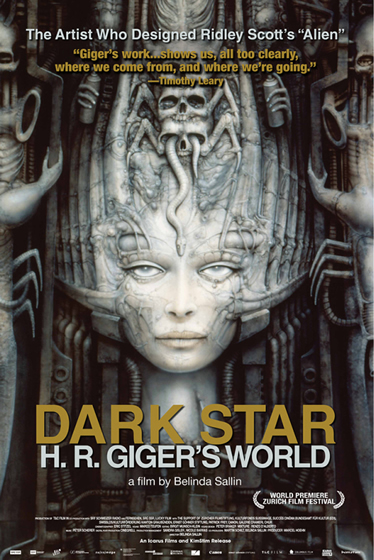 Belinda Sallin’s “Dark Star- HR Giger’s World” is an elegiac, intimate documentary about the gentle giant futurist with the macabre sensibility who, among other things, was responsible for the monstrous visuals in “Alien”.
Belinda Sallin’s “Dark Star- HR Giger’s World” is an elegiac, intimate documentary about the gentle giant futurist with the macabre sensibility who, among other things, was responsible for the monstrous visuals in “Alien”.
Giger was apparently haunted since childhood, able to channel through his art the deep unconscious fears that lurk in the human subconscious. He admits to facing his fear through his art, telling a childhood tale. Frightened by a room of mummies in a museum, he spent the following days there conquering his fear. As a tot, he dragged a skull (a gift from his father) around the street ona string a pull toy.
Indeed Egyptian motifs blend in his work along with erotic and sinewy body forms, part vegetal, part animal, reminiscent of Gunther von Hagens’s plastinated Body Worlds, as chilling as the medical abnormalities on view in The Musee Dupuytren.
One friend and Psychotherapist Stanislav Grof, describes his work as buried images of the terrifying journey through the birth canal to the light of the world.
Giger was already very ill when Sallin interviewed him, but the conversations and tours of his hand created world are astonishing.
We visit Giger at work, surrounded by his entourage: agent Leslie Barany, Hans H. Kunz, poster designer and lifetime poster partner, and Grof, the author of a new book on Giger. as well his assistant Tom Gabriel Fischer (Fischer founded the legendary bands “Hellhammer” and “Celtic Frost”. and is currently the guitarist and singer of “Triptykon”) wife Carmen Maria Giger and his fond mother-in-law and accountant
Carmen Scheifele De Vega. Fragile, melancholy Giger speaks of his model and love Swiss actress Li Tobler, who committed suicide in 1975.
Hans H. Kunz, a vet of SF’s Summer of Love opened Switzerland’s first poster shop. Giger’s posters build his fame and working capitol, eventually leading him to Hollywood projects.
Outside artist Giger, misunderstood by the art world, bought back much of his work and eventually opened a museum Chateau St. Germain in Gruyères, Switzerland.
Think of Giger as a cross between Gaudi and Salvador Dali, with a touch of Wilfredo Lam and Francis Bacon; a designer who blended the baroque, gothic and Art Nouveau practice with his own “biomechanoids” genius. He was a master of air-brush as well as a sculpture and interior designer. We tour his sculpture garden, as strange in it’s way as the famous Gardens of Bamarza. The bar he fashioned for his museum is a serpentine glory of gothic vaulted groins, each resembling an immense vertabrae.
Archival footage from Giger’s creative childhood mix with tours of his world: the train set he rides in around his maze of a property, the gallery deeply encrusted with his creations , and the working bar, a marvel .
One3 wonders how Giger moved through his labryrinthine ramshackle house/ scupture in Zurich, Indeed he tumbled down the stairs and died at 74, shortly after completing these interviews. Sallin’s ending is remarkable. Goodnight Mr. Giger, wherever you are.
